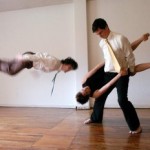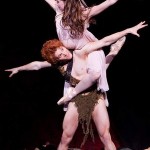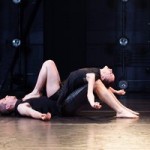Archive for May, 2012
Headlongers make small bits meaningful
Author: adminMay 11
Posted: Sun, May. 6, 2012, 4:56 PM
By Merilyn Jackson
FOR THE INQUIRER
The threesome who compose the Headlong Dance Theater brought tales of their early, communal living arrangement as well as baskets full of onions to the Performance Garage. The artists have a knack for finding meaning in small things.J.J. TIZIOUR / jjtiziou.net
After years of making more conceptual work and implementing teaching projects, the triumvirate that makes up Headlong Dance Theater — Amy Smith, David Brick, and Andrew Simonet — came together again over the weekend at the Performance Garage to dance. Their new work, directed by Swarthmore College professor K. Elizabeth Stevens, is called Desire. For what, it doesn’t say. But all it made me want to do was cry.
It was all about onions, you see. There were four huge laundry hampers full of big, juicy golden onions that pretty soon got dumped, rolling all over the stage for these actor/dancers to mash pell-mell with their bare feet — and bodies, too, once the juices started oozing and they slipped on them.
There was a microphone to one side of the stage where Smith recounted anecdotes about their early, idealistic days together. Brick and Simonet also took turns at the mic, and it was as though three siblings were telling versions of their cildhood.
They lived communally, two of them as vegans envying Brick his coffees’ real half-and-half over their soy version. They shared clothes — three pairs of shorts among them — as they sprinkled onion seeds down the rows Brick had sown. Once they graduated from Wesleyan, they migrated to Philly. Here, they sowed seeds for new kinds of dance.
What endears the Headlongers to everyone is how they take small bits of life and turn them into something meaningful, familiar, sometimes a little sinister. Masters at juxtaposing melancholy texts with nostalgic music and goofy dancing, they jut out their legs and wiggle their arms in opposite directions in simpleminded steps. They drop behind one another, gently aping the other until the one who’s being aped peels away.
In one part, a song relays that it’s a “custom to dance after funerals. We like to waltz,” and the three take turns waltzing among the crushed onions, managing to sidestep each one. They know how to lead an audience to focus on several aspects of their theater-making all at once.
The set and lighting were by Thom Weaver — three boxes sided with fabric that represent tents. Each of the dancers emerges from his or her individual spaces or retreats to them. Simonet comes out on all fours in an animal head, and later so does Brick as a unicorn. We all know they’re mythical, so is he telling us not to believe what we’ve heard and seen?
Each of them (literally or figuratively) peeled away an onion at various times throughout the show — a kind of search to find the center of meaning, the kernel of truth in who we are. Of course, an onion has no center, so it makes a good metaphor for life and all the things we do as we journey through it.
And that could make you smile through your tears.
Watch sports videos you won’t find anywhere else
Read more: http://www.philly.com/philly/entertainment/20120506_Headlongers_make_small_bits_meaningful.html#ixzz1uWnp7RgV
Watch sports videos you won’t find anywhere else
Review: Ballet’s ‘Peter Pan’ has ups and downs
Author: adminMay 11
Posted: Fri, May. 4, 2012, 9:37 PM
By Merilyn Jackson
FOR THE INQUIRER
In J.M. Barrie’s Peter Pan, the boy was dressed in leaves, as perhaps was Pan, the Greek god of nature whom Barrie had in mind. When Pennsylvania Ballet gave the ballet Peter Pan its Philadelphia premiere Thursday night at the Academy of Music with Alexander Peters as the boy from Neverland, his sprightly body was not clad in leaves, but scantily enough in shorts and straps around his chest to suggest a ruffian from the wilds.
The Oregon Ballet originally commissioned choreographer Trey McIntyre to create this Peter Pan, his first full-length ballet, but funding problems caused him to set the work on the Houston Ballet in 2002. Though he came to Philadelphia to polish his gem on this company, there were still some rough edges opening night.
The flying sequences, in which Wendy (Evelyn Kocak), John (Jonathan Stiles), and Michael (Abigail Mentzer) take off with Peter, had to be rehearsed in another theater until two days before the first performance. Pan was also the god of theater criticism, so I think he might have forgiven the slight scenery malfunctions and occasional missteps when dancers could not always find their places.
As delightful as he was aerially, the young Alexander Peters was not up to par partnering a taller Kocak. In one horizontal slide, he thudded rather than slid her; later, Kocak, with Zachary Hench as Hook, performed the slide perfectly.
With her striking, sophisticated looks, Amy Aldridge — who rose from apprentice in 1994 to principal in 2001 and is a senior company member — struck me as poor casting for Tinkerbell. However, she appeared only once, briefly, and then was represented by a flickering light. (McIntyre did not include one of the most endearing sections for young audiences — for many their first audience-participation experience — when Tink is poisoned and they have to clap her back to life.)
The great story ballets — Firebird, Spartacus, Swan Lake, Romeo and Juliet — link generations across time with upswept melodic themes that weave throughout, signaling plot changes. The humorless hodgepodge score of Sir Edward Elgar’s music, arranged by Niel DePonte, was the slightest, most unmagical element of the ballet.
Nevertheless, there was plenty of magic inside the gorgeous “Grand Old Lady of Locust Street” Thursday night. Hench as Hook was commanding, the huge crocodile grouchily hungry. And wonderful group dances among the Shadows, Redskins, Pirates, Lost Boys, and Mermaids — where soon-to-retire Arantxa Ochoa does a comic turn — save this darkly imagined Peter Pan. You’ll live forever in our hearts, Peter.
The art of becoming, at the fidget space
Author: adminMay 11
FOR THE INQUIRER
The fidget space is on North Mascher Street just above Cecil B. Moore Avenue, in a little niche of the arts neighborhood around the corner from Mascher Space and between Crane Arts on American Street and Pig Iron’s school on North Second Street.
Dancer/choreographer Megan Bridge and composer/videographer Peter Price opened the walk-up loft at the top of the building in 2009 as a research laboratory for dance, and many local and out-of-town artists have worked in the space. On Thursday, Bridge, Zornitsa Stoyanova, and Annie Wilson danced while performance artist Mauri Walton sketched and drew words backward on the freshly painted white walls. It was called situation: becoming and was as much an art installation as a performance.
At the Friday evening show, I waited outside the curtained-off space with a dozen or so other audience members (only 20 are admitted each night) until we were led inside together. We were asked to remove our shoes and invited to lounge on a white futon surrounded by pillows. This was theater-in-the-round flipped, with the audience in the center of the space and all the action revolving around us.
White Roman shades completely covered the huge factory windows on two sides of the space, blocking the magnificent city views. They act as screens for Price’s geometric video treatments that play around the room kaleidoscopically, dizzyingly, making me glad to be already on the floor.
Stoyanova saunters around us faintly smiling, then stops and leans into us, telling us one by one the secret message, which we must pass on. Wilson rocks sideways on a child’s toy. Then they gather, with Bridge on a couch, looking like beautiful mannequins in their white architecturally constructed costumes (by Heidi Barr). Soon they are prancing or skipping around us, stopping to isolate body parts, with even some subtle popping and locking. Wilson disappears into the living quarters to change into a black jumpsuit number with pops of color, and Walton helps her to roll up the shades to the cityscape.
Price sits behind a paper cutout globe like a wizard calmly orchestrating the nuttiness. Wilson sits chopping long-stemmed carrots, Bridge appears in her bunny suit, Stoyanova dresses in hot pink, dancing with a skull, or digs in a pile of soil, Walton lays objects out around the floor until we are each invited over to the bar for a beverage, and the piece just fizzles out in whispering fun.
Dance review: Koresh re-ignites ‘Bolero’
Author: adminMay 11
FOR THE INQUIRER
What modern choreographer doesn’t want to sink his teeth into making a new Bolero? Sure, everybody’s done it. But Roni Koresh really made a quirky new one for Koresh Dance Company’s spring opener Thursday night at its home base, the Suzanne Roberts Theatre. Koresh titled the evening’s four works “Out/Line,” which also was the name of the first of three world premieres on the bill.
But it was his fresh take on Bolero that outshone all the other works. Bronislawa Nijinska choreographed the first Bolero, which was commissioned by Ida Rubenstein in 1928. Nijinska set it in a tavern, where Rubenstein danced on tabletop. But composer Maurice Ravel had envisioned the work in a factorylike setting, because its rhythms sounded mechanically driven. Koresh boldly strayed from the usual sensual, even erotic renditions, taking his cue from Ravel’s original vision and adding lots of humorous notes. His sensational dancers even smiled while dancing it, and I don’t think I’ve ever seen a smiling Bolero before.
There were some signature Koresh gestures throughout: splayed fingers, shaky hands, elbows up, clasped hands, and eyes raised to heaven. But they seemed there as a grounding sign, a cheeky reminder that, hey, this is fun, seriously.
Mechanistically, sometimes even militaristically, the dancers emerge from the black background to the harshly lit (by Robb Anderson) foreground in solos, pairs, and trios, with, eventually, the full company, and then disappear in groups back into the black. Their chic black costumes were by Bela Shehu.
Koresh varies several simple step combinations, mostly walking-based, using them like the music, to build the sensation of the dance. Joe Cotler, Micah Geyer, and Eric Bean are the current male lineup in the now-21-year-old company and, as usual, they carry the load of partnering, though there is no heavy lifting. Here they bend forward, hands on the floor, swinging their legs behind them from side to side. They make wide-open giant steps and when the charming social dancing begins, the women partner and lead each other. Everyone waits for the final falling crescendo of the music, but Koresh adds a teensy coda note with one dancer in a spot, just for laughs.
Out/Line was the evening’s weakest piece, not only for its loud, pointlessly boring music, but also for its relentlessly pugilistic, martial-arts look and length.
The Heart had many moments of sweet appeal, but these long, episodic works are really wearing thin. Who wants to nibble at a gallimaufry of cold scraps when you can feast at a fully conceived and realized banquet like Koresh’s Bolero?



